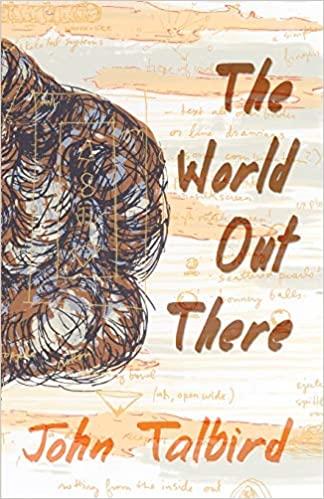| <- Back to main page |
(Madville Publishing)
John Talbird’s contemporary story portrays the interpersonal dynamics of three rather ordinary, complex, and confused characters. It’s a clear-eyed look at how circumstances cause relationships to deepen or unravel and, in turn, create new factors that must be dealt with.

The web of interactions keeps life from being smooth, and when events from the “world outside,” emphasized in the title, intrude, they can unsettle and create turmoil, upsetting the best-laid plans, the best intentions. Outside complications make the normal stew of life more interesting, and watching the principal characters dealing with them, lets them take shape as living people. Tossed about, sometimes feeling helpless, other times simply disoriented, they move toward what seems to be ways to make their lives work out. In the process, they make choices that affect their lives and those of others. And always, they have to deal with the consequences.
Told in the present tense, The World Outside traces the struggle of Jan and Ray, who are trying to redefine their relationship post marriage, while maintaining some rational order for their son, Hank. Jan, confused about her own desire to be a good mother and somehow figure out her own life, starts a casual affair with William, her boss at the bookstore where she works, which adds its own complications.
Talbird tells his tale with a delicious sense of immediacy. The characters can seem propelled through the events. Combined with a knack for making ordinary situations both vivid and interesting, this becomes a fast-paced narrative.
For Jan, things go wrong from the opening chapter, when the brakes on her car fail, plunging herself and her son into the lake. But there is a sense that we’ve entered in the middle of things, and that it’s been some time since things actually went right for any of them:
Her father will probably buy her another car, but she is thirty-four. When will it stop? When will she not need to be taken care of? She should call Hank’s father, tell him what happened, but it is late. The VCR clock reads 2:33. Actually, Ray would probably be up, but he might be out and Jan’s not crazy about talking to what’s-her-name. The new girlfriend is a decade younger and Jan hates when she catches her on the phone, that coldness, as if that little chick has any right, as if Jan gives a shit about Ray, as if she would consider getting back with him even if he were single and willing.
In one sense, the title is misleading. Yes, the machinations of the world out there factors into their lives, but the most powerful, most significant (and interesting) struggles the characters face are often those of their own making. They often perpetuate those problems, sometimes through an inability to focus, rather than solve them complicates their lives:
“All right. I don’t know what I am, even what I like.” She turns away and reaches for the blinds behind the couch, puts her index and middle fingers through a slit and spreads them. That tiny slit lets in a brightness too intense to stare at in this perpetual dusk, she he just watches the light on her cheek, the dust motes drift, until she lets go, looks back at him. “I know I’ve not really talked about my childhood much. Mainly cause it’s kind of boring.” She runs her hand through her hair. “God, I must look like shit.”
A story takes place in a context, and the context in this book is a troubled time, not unlike our own. As the story develops, a serial killer is on the rampage. With a shortage of leads, the city is in lockdown, both by mandate and out of fear.
This lets Talbird take a complex relationships story and stir in problems from the world “out there”— showing how events totally outside their control affect the characters’ lives, adding another layer of difficulty to the challenge of getting by. Given that mix, it’s no surprise that there is little logic to its madness and things can happen for no apparent reason. If we do create and perpetuate our own problems, the ones thrust on us are out of our control. Thus, Talbird’s construct is a prescient and almost perfect metaphor for the way our current pandemic has altered and disrupted our lives.
These are rich stories of people the author seems to understand and know. In the same way that writers like John Cheever and Joyce Carol Oates explored and portrayed the nuances and people of their own places and times, it is realistic. Such study requires examining events and reactions without ascribing meaning to them. People do what they do, and their actions mean what they mean. The characters can be proactive, helpful, and kind, or self-destructive and angry, in equal measure. They are people who act their parts or act out, who fulfill their potential, or fail to, or perhaps even choose another path.
- Ed Teja 